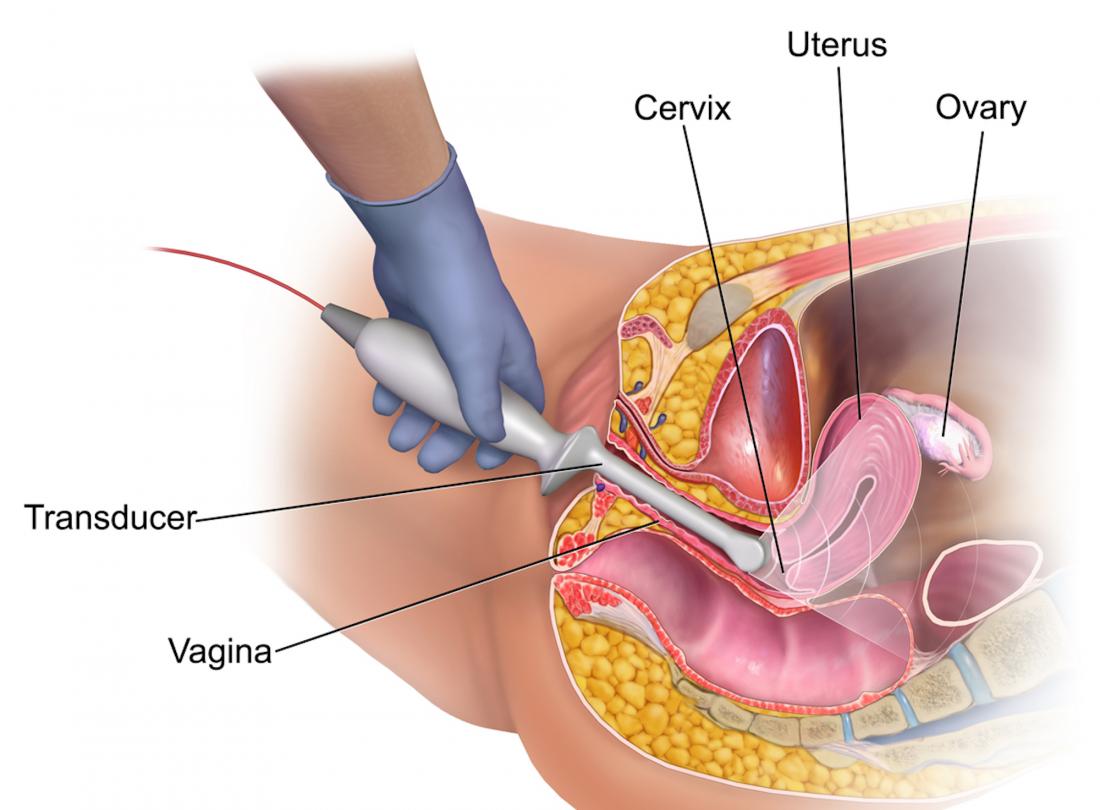An ultrasound uses high-frequency sound waves to produce detailed images of internal organs.
Unlike X-rays, ultrasound scanning techniques do not use radiation, which means that they have no harmful side effects and are very safe.
In this article, we explain the uses of transvaginal ultrasounds and how to prepare for one. We also cover what to expect during the procedure.
What is a transvaginal ultrasound used for?

A transvaginal ultrasound can check for ovarian cysts, ovarian tumors, fibroids, and polyps.
Image credit: BruceBlaus, 2015
When most people hear the term ultrasound, they will picture a transabdominal ultrasound, in which doctors pass a device called a transducer over the surface of the skin to obtain internal images.
Although a transabdominal ultrasound can provide information about the abdominal organs, this procedure does not obtain detailed images of the organs in the pelvic region.
Some symptoms and medical conditions, such as endometriosis, require images of a higher quality than it is possible to achieve using a transabdominal ultrasound.
Unlike transabdominal ultrasounds, a transvaginal ultrasound is an internal examination. The procedure involves the insertion of the transducer into the vagina to produce incredibly detailed images of the organs in the pelvic region.
It may be necessary to use a transvaginal ultrasound to examine the following internal organs:
- vagina
- cervix
- uterus
- fallopian tubes
- ovaries
- urinary bladder
Transvaginal ultrasounds are also useful to check for:
Doctors may recommend that people have a transvaginal ultrasound for a variety of reasons. For example, the procedure might be necessary for someone who is experiencing the following signs and symptoms:
- pelvic pain
- unexplained vaginal bleeding
- infertility
- abnormal results from a pelvic or abdominal exam
Doctors may also recommend that some pregnant women have a transvaginal ultrasound as it can be helpful for:
- checking the heartbeat of the fetus
- confirming the date of pregnancy
- assessing the condition of the placenta
- checking for ectopic pregnancy
- monitoring pregnancies with a higher risk of miscarriage
How to prepare for a transvaginal ultrasound
A transvaginal ultrasound is a simple and painless procedure that requires very little preparation.
The doctor may request that your bladder be empty or only partially full. Conversely, they may ask you to come with a full bladder. If this is the case, they may advise you to drink 32 ounces of liquid over a 30-minute period, starting 60 minutes before the examination begins.
The probe is mildly uncomfortable. If you have any concerns about the procedure and how it will feel, talk to the doctor to learn more.
If you have your menstrual period and are wearing a tampon, you will need to remove it before the ultrasound.
Procedure

A sonographer sees the images captured by the transducer on a screen.
A doctor or specially trained technician, called a sonographer, will perform most transvaginal ultrasounds.
Once inside the examination room, the individual will need to undress from the waist down and put on a hospital gown before lying down on the examination table with their knees bent. In most cases, they will have a sheet covering them.
The transducer resembles a wand in shape and is slightly larger than a tampon. The sonographer will cover the transducer with a condom and lubricating gel before inserting it into the vagina.
Once the transducer is in place, it will produce sound waves that bounce off the internal organs back to it. The sonographer will use side-to-side and rotational movements to bring different areas into focus. The transducer will transmit the information directly to a TV monitor where it will appear as a series of images.
The images that the transducer captures will display immediately on the screen, making it possible for the sonographer and individual to monitor the examination process in real time.
Risks and side effects
Unlike traditional X-rays, a transvaginal ultrasound does not use any radiation. As a result, it is a very safe procedure with no known risks.
It is perfectly safe to perform transvaginal ultrasounds when women are pregnant, and the procedure presents no risk to the fetus.
During the transducer insertion, people may feel some pressure and minimal discomfort. This feeling should subside once the ultrasound has finished.
It is essential to always communicate with the sonographer or doctor performing the examination and to let them know if anything feels particularly uncomfortable.
Interpreting the results
If the doctor performs the ultrasound, the individual will get their results immediately. However, if a sonographer carries out the procedure, they will send the images to a radiologist for analysis. The radiologist will then send a written report of the results to the doctor.
Either way, it is important to discuss the ultrasound with the doctor afterward, so that they can explain what the results mean. This discussion can take place either in person or over the phone.
Takeaway
A transvaginal ultrasound is an extremely safe procedure with no associated risks. People might experience some discomfort during the examination, but this is temporary and should go away after the ultrasound.
The test may take around 30–60 minutes in total, and the results are usually available 24–48 hours after the examination.
If people experience extreme discomfort during the ultrasound, the doctor or sonographer may perform a transabdominal ultrasound instead.

